WHAT'S NEW:
BACKGROUND:
Mission
Project Description
Cruise Plans:
Participants
Technology (ROV, ships, etc.)
Future Plans
Results:
1998 NeMO Cruise
Axial 1998 "Eruption"
Logbook
July 13, 1999
July 13, 1999
Contents:
- News from Thompson
- Participant Perspective
- Logbook from Teacher at Sea
- Question/Answer from shore to sea
Thompson Science Report
Perspectives at the End of NeMO99
Bob Embley-NeMO99 Chief Scientist
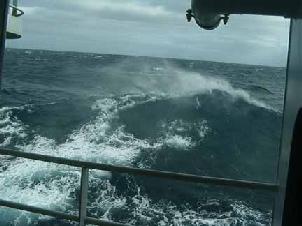 Heavy seas on the last days of the cruise prohibited any further dives and made the ride home a rock n' roll experience. |
Overall, this year's cruise rivaled the success of NeMO98 and the scientific party will again have a full load of samples and data to analyze. The effects of the 1998 eruption are still apparent on the eastern side of the caldera where the lava flow was erupted. Venting continues in many places (e.g. Marker 33, Cloud, and Magnesia), whereas there has been reduction or cessation in others. Although the amount of visually apparent microbial activity (such as the white floc in the water column) has decreased, there continues to be concentrated "snowblower" activity at some vents (e.g. Magnesia Vent) and hyperthermophilic microbes were again found in abundance at most of the diffuse (low temperature) sites, (whose temperature is well below their optimal growth rate). These observations lead to the conclusion that there is still enhanced subsurface microbial growth more than a year and a half after the eruption.
We found the likely southern end of the lava flow about 6 kilometers south of the caldera lava along a spectacular fissure system that was followed for hundreds of meters. In some places the eruption was entirely contained in the 1 to 2 meter wide fissure. Eventually, it overflowed its fissure and erupted in the large mound of lava that we first saw last year. Farther north towards the caldera, the trace of the 1998 lava became more confused as the slightly older eruptions mixed with the 1998 lava. Active hydrothermal venting was only found on the summit of Axial, probably where the underlying zone of molten lava permanently resides. The summit area contains hydrothermal systems formed during several different volcanic or tectonic (earthquake generated) events, providing a natural laboratory for studying colonization and evolution of these unique chemosynthetic ecosystems.
One of the viewers from our WWW audience asked the question:
"What
are we doing out here that will make a difference in people's daily
lives?"
This is a good question, and I'd like to try and answer it on
several levels. First of all, I believe that ocean floor research is one
of the last frontiers of terrestrial exploration. We literally know more
about what the surface of the moon or even Mars looks like than we do the
floor of Earth's oceans. Hidden below the ocean's is the earth's largest
volcanic system, the
60,000 km long Mid-Ocean Ridge. The ridge grows by
the process of
seafloor spreading, by which the earth is actually renewing
its surface. Surprisingly, little is known about the actual processes
that form this feature, because of the harsh conditions and remoteness of
the deep ocean. Volcanic eruptions have to frequently occur along some
portion of this ridge, but the only place that can actually be
monitored
is the small outlier of the ridge in the Northeast Pacific Ocean (because
of the Navy's hydrophone net). Knowing when an eruption occurs allows
scientists to study the processes that occur when molten rock meets
chilled seawater on a giant scale. The chemical and biological processes
that occur during and immediately following these events are of
increasing interest because of the extremes of temperature and pressure
associated with deepsea volcanism. Herein lies the promise of NeMO and
other similar projects that seek to monitor active processes in the last
frontier environment on earth. We will finally begin to visualize and
understand the most active environments on the ocean floor as we can a
critical estuary or a rain forest on land. Now is the time to do this,
before we, in ignorance, destroy what may help us in the future. Earlier
this year, Canada took an historic step in declaring that a major deep-sea
vent field on the
Endeavour Ridge(about 120 miles north of Axial Volcano)
was under study as a possible marine protected area. Most of the
Mid-Ocean Ridge is in international waters and therefore not subject to
national jurisdiction.
One of the goals of NeMO is a baseline of information that will aid future generations in understanding these environments. Such "basic" research many times leads to applications that could not be predicted at the time. The United States has invested in such basic research as a national policy for more than half a century, and it is apparent that it has paid back to society much more than its bottom line. In the case of NeMO, there may also be more immediate payoffs. The extremes of heat and pressure at the deep hot vent sites give rise to microbial life that may be quite different than anything in the terrestrial ecosystem. On this cruise, a microbe that can thrive at the very fringe of what life can survive at (110 C) was discovered at one of the vents formed following the eruption. Some such "extremophiles" have evolved to produce enzymes that are of great interest to the biotechnology industry. One of the premises of NeMO (based on earlier work) is that Axial Volcano is the best location for these studies because its high level of volcanic activity provides better access to these extreme environments. We all feel extremely pleased that all of the components came together so well, and that nature cooperated (with the eruption) to produce the wonderful natural laboratory within the caldera of Axial Volcano. This year we received a extra bonus when the Rumbleometer was successfully recovered from its lava imprisonment to (hopefully) yield new important data on seafloor eruptions.
By continuing the interdisciplinary study of processes at Axial, we begin to understand how the rest of the Mid-Ocean Ridge works and by inference how the planet reforms its surface.
Listing of all Science News postings
Life at Sea: Participant Perspective
Not available today.
Nicole Nasby
Oregon State University
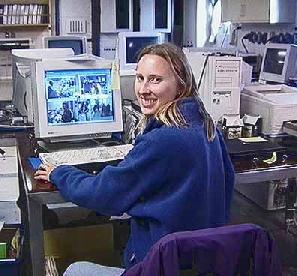 Well, I
guess I should introduce myself as the "woman behind the web" and
no, I'm not talking spiders. Although I am a scientist, my role on this
cruise has been more of a journalistic nature. I have been the photographer
and editor for the daily information that has been sent out on the web
page. I guess you could say I've gotten the "birds-eye" view of what goes
on around here. The things that have impressed me the most are the amount
of preparation and planning required to make a complex operation like
this run smoothly, as well as the amount of teamwork and collaboration
between scientists and engineers of varying disciplines. It was a treat
to see geologists, chemists and biologists working side by side and offering
discussions from their perspective. And of course I've learned that the
most important qualities to have on a cruise like this are patience and
flexibility! Mother Ocean is a powerful force and studying a volcano
1500 meters below the ocean surface is not a simple task. Overall
I am impressed with the NeMO program
as a long term monitoring site and with all of the of collaborative efforts
that are involved.
Well, I
guess I should introduce myself as the "woman behind the web" and
no, I'm not talking spiders. Although I am a scientist, my role on this
cruise has been more of a journalistic nature. I have been the photographer
and editor for the daily information that has been sent out on the web
page. I guess you could say I've gotten the "birds-eye" view of what goes
on around here. The things that have impressed me the most are the amount
of preparation and planning required to make a complex operation like
this run smoothly, as well as the amount of teamwork and collaboration
between scientists and engineers of varying disciplines. It was a treat
to see geologists, chemists and biologists working side by side and offering
discussions from their perspective. And of course I've learned that the
most important qualities to have on a cruise like this are patience and
flexibility! Mother Ocean is a powerful force and studying a volcano
1500 meters below the ocean surface is not a simple task. Overall
I am impressed with the NeMO program
as a long term monitoring site and with all of the of collaborative efforts
that are involved.
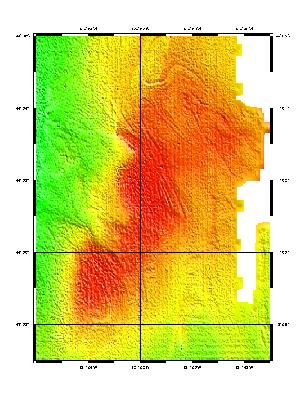 Aside from
an overall passion for the ocean, my connection to this cruise is through
Chief Scientist Bob Embley.
I am presently a graduate student at Oregon State University in oceanography
and am working on a Masters project with Dr. Embley looking at using high
resolution sonar images to do a habitat assessment of Heceta bank (map
left), a major fishing bank off the coast of Oregon. My background is
in biology and I'm in the Marine
Resource Management program at OSU. My interests are in marine conservation
and management issues, and I am interested in the applications of using
the sonar habitat assessment project for policy decisions in the areas
of marine fisheries and marine protected areas. Originally the plan for
this cruise was to spend the last few days at Heceta bank and do some
exploring with ROPOS, but again, this is where flexibility comes in -
we ended up needing all the remaining days to finish up the work at Axial.
Aside from
an overall passion for the ocean, my connection to this cruise is through
Chief Scientist Bob Embley.
I am presently a graduate student at Oregon State University in oceanography
and am working on a Masters project with Dr. Embley looking at using high
resolution sonar images to do a habitat assessment of Heceta bank (map
left), a major fishing bank off the coast of Oregon. My background is
in biology and I'm in the Marine
Resource Management program at OSU. My interests are in marine conservation
and management issues, and I am interested in the applications of using
the sonar habitat assessment project for policy decisions in the areas
of marine fisheries and marine protected areas. Originally the plan for
this cruise was to spend the last few days at Heceta bank and do some
exploring with ROPOS, but again, this is where flexibility comes in -
we ended up needing all the remaining days to finish up the work at Axial.
Listing of all Perspectives postings
Teacher At Sea Logbook
Teachers log #23 7/13/99
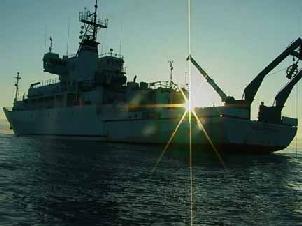 The
day has finally come that we both dread and look forward to. Over the
last few days many have asked if I was ready for the cruise to come to
an end. I definitely have mixed emotions about it. This is likely the
case whenever you immerse yourself in a task that you find intellectually
stimulating and adventurous. Never before had I attempted such a journey;
to leave home and family and join a staff
of excellent scientists and students for a month long investigation
of a topic that I have always thought was fantastic. Fourteen years ago
I was introduced to Steve
Hammond (Program Manager for the NOAA EOI Program) at Hatfield
Marine Science Center in Newport Oregon. His topic was the hydrothermal
venting that was occurring along the
The
day has finally come that we both dread and look forward to. Over the
last few days many have asked if I was ready for the cruise to come to
an end. I definitely have mixed emotions about it. This is likely the
case whenever you immerse yourself in a task that you find intellectually
stimulating and adventurous. Never before had I attempted such a journey;
to leave home and family and join a staff
of excellent scientists and students for a month long investigation
of a topic that I have always thought was fantastic. Fourteen years ago
I was introduced to Steve
Hammond (Program Manager for the NOAA EOI Program) at Hatfield
Marine Science Center in Newport Oregon. His topic was the hydrothermal
venting that was occurring along the 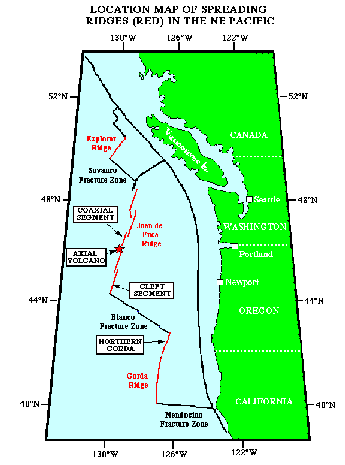 Juan
de Fuca Ridge (map left, click for full size) and Axial Volcano. At the
time, I had no idea these things existed so close. They seemed
to be at some exotic local that I knew I would never come close to visiting.
For the last month, I have had the privilege of observing true science
first hand at a place I never thought possible. The first time that I
stepped into the ROPOS lab
and had opportunity to view the unique and bizarre world of a hydrothermal
vent was fantastic. It certainly beats sitting at home watching a NOVA
special or National Geographic video. I have been able to share with
many members of the science staff my ideas and ask questions. The images
I will return to the classroom with are priceless. To actually see
a fissure in the oceans crust where sea floor spreading is occurring is
so far superior to any text or periodical photo. You can actually
see the heat rising from the crust in the vent fluid. The graceful movements
of animals seem so illogical at the extreme pressure they exist at. To
hear the excitement in peoples voices, both those who are new and those
that are experienced, exclaiming how marvelous what they are witnessing,
can be rather contagious. You get to the point that you don't want the
dive to end. The collegial atmosphere is one that we don't see as often
as we should in any profession. These are just some of the reasons I,
and probably others dread this day.
Juan
de Fuca Ridge (map left, click for full size) and Axial Volcano. At the
time, I had no idea these things existed so close. They seemed
to be at some exotic local that I knew I would never come close to visiting.
For the last month, I have had the privilege of observing true science
first hand at a place I never thought possible. The first time that I
stepped into the ROPOS lab
and had opportunity to view the unique and bizarre world of a hydrothermal
vent was fantastic. It certainly beats sitting at home watching a NOVA
special or National Geographic video. I have been able to share with
many members of the science staff my ideas and ask questions. The images
I will return to the classroom with are priceless. To actually see
a fissure in the oceans crust where sea floor spreading is occurring is
so far superior to any text or periodical photo. You can actually
see the heat rising from the crust in the vent fluid. The graceful movements
of animals seem so illogical at the extreme pressure they exist at. To
hear the excitement in peoples voices, both those who are new and those
that are experienced, exclaiming how marvelous what they are witnessing,
can be rather contagious. You get to the point that you don't want the
dive to end. The collegial atmosphere is one that we don't see as often
as we should in any profession. These are just some of the reasons I,
and probably others dread this day.
As far as why I am looking forward to the end, well what can I say, I've been at sea for a month. Some of the joys of life at sea include sleeping in a cramped cold bunk, eating regularly (not something I do) and forgetting what day of the week it is because weekends do not exist. I've had time to research a fair bit, I've read some good books, and even sat in on some good movies. But it is time to rejoin the real world I live in. I bring back a lot of thoughts and ideas, some bigger than others. I wish to thank my family for allowing me this opportunity to be away from home and take part in an adventure. The families of the other members of this cruise need thanking also. To all those who have made my job a truly enjoyable experience, thank you. This has been the best classroom learning experience I have had the pleasure to be in. As the NeMO 1999 cruise ends, thanks to all those who logged on to see how we were doing out here.
Logbook of all Teacher At Sea postings
Questions & Answers
Question:
I note with interest that this question and answer forum is not just for students. So, I will move to a question that is posed to me, over and over. My daughter is also among the crew onboard, as a lab technician from the University of Washigton. I know why she is excited by what she does - I know why I am excited by what she does. We are just underwater people!. But, as I speak with people about what she is doing for this past month, the one question seems to come up from each person to whom I speak is,
"This is all very interesting. but just what difference does all this make to our everyday lives.?"
And that in a "nutshell" is my question. Beyond the fact that the mountain is there, what can we tell people just why are we climbing this one? Thank you so much for the time you have spent on this WEB site ( and by the way, send my daughter home soon!)
Jeanette Roadruck
Answer:
See Chief Scientist, Bob Embley's answer in today's science report.
All Questions/Answers from sea
![]() Send
Your Question to NeMO
Send
Your Question to NeMO
(oar.pmel.vents.webmaster@noaa.gov)